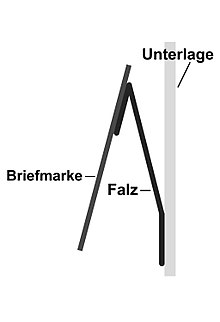Stamp fold
A stamp hinge or short- fold , also adhesive hinge , is a single rubber-coated glassine and serves for the attachment of stamps on a support (for. Example, album).
history
Before the invention of the stamp fold
Before the invention of the stamp fold, the philatelists had to glue their collectibles into the stamp album, which usually damaged them. Many philatelists were concerned about a better way to store stamps. As early as 1867 , useful suggestions from French philatelists emerged who suggested folding over the unneeded sheet edges on the stamps so that part of the adhesive surface was glued to the stamp and the other part of the sheet edge to the base. Of course, this type of fastening was only possible if enough arched edges were available.
Dauth's invention
The Frankfurt stamp dealer Dauth also found the method of attaching stamps by means of sheet edges to be too cumbersome. That is why, in 1881 , he presented the world's first stamp fold. This worked on the principle of attaching postage stamps to album pages using sheet margins, but was specially made for this. At that time, the postage stamp folds were still called "Marken-Charniere" . 1000 of the world's first stamp folds cost 75 pfennigs.
Improvements and new shapes
In the decades that followed, the stamp fold established itself as a fastening means for stamps among philatelists. Of course, this was also taken into account when producing the stamp albums. Furthermore, new shapes kept coming onto the market. There were stamp folds that no longer had to be folded over to attach the stamp to the album, as they were mutually rubberized. However, this variant could not prevail, although it was advertised that the albums would be less bulky when used than when using one-sided gummed folds.
In 1938 the already eagerly anticipated Schonfalzen came onto the market. So far, the gumming of unstamped stamps has been damaged a little by attaching a stamp fold. Philatelists have had to accept this until now, as there was no better way to store their stamps. The folds promised not to damage the gum on the stamp. This meant that even after removing the folds from the stamp, there would be no trace of it. The secret of the Schonfalze was a special dry adhesive, which, however, after a few years caused ugly stains on the stamp as a result of breaking through, which led to major material damage.
The decline of the stamp fold
After the Second World War , the stamp folds disappeared more and more from the collections. The reason for this was the invention of clip pockets and other systems of stamp storage that no longer required sticking the stamps anywhere. Although the postage stamp folds do not damage stamped stamps that no longer have gum, they are no longer used in the previous measure.
The fact that it was now easily possible to collect postage stamps with intact gumming meant that philatelists also tried to get them from years before the Second World War. This led to a sharp drop in the price of postage stamps with marks on the back of removed postage folds, but a sharp rise in the price of postage stamps with flawless gum.
use
Postage stamp folds have been used by almost all philatelists around the globe for decades. To do this, hold the stamp fold with tweezers and moisten a point in the upper area of the gummed side. This works best with a finger or a swab. The moistened side is then pressed onto the back of the stamp. This should be done only a few millimeters below the upper edge of the stamp so that the stamp fold does not protrude below the stamp later. Then the lower part of the fold on the gummed side is moistened exactly as described and glued to the intended place on the pad (album). It is advisable to moisten only a small part and to allow the moistened area to dry a little before sticking it on, as this makes it easier to remove the stamp from the album later if necessary.
Large-format blocks, compound prints, pieces of letters or whole pieces require the use of several folds. As an alternative, you can also use wet-adhesive photo corners or, even better, so-called block corners (larger than the previous ones).
distance
To remove a postage stamp that has been stuck in an album with a postage fold, you move the tweezers under it and turn it over. Then you can easily cut through the stamp fold or pull it off the album sheet. Finally, you can carefully pull the stamp fold off the stamp. However, this does not always work completely and can damage the brand if you are too hasty.
Remnants of folds that are too short to stick in the album can also be lengthened with a piece of another fold.
It is not advisable to wash off the stamp fold with unused stamps, as all of the gum on the stamps is washed off. There are stamp removers in specialist shops that are good for unfolding and are very gentle on the original rubber. The stamped stamps can of course be removed with water.
literature
Wolfram Grallert: Lexikon der Philatelie , 3rd, unchanged edition, Phil * Creativ, Schwalmtal 2015, ISBN 978-3-932198-38-0 , keywords: fold , adhesive fold .

